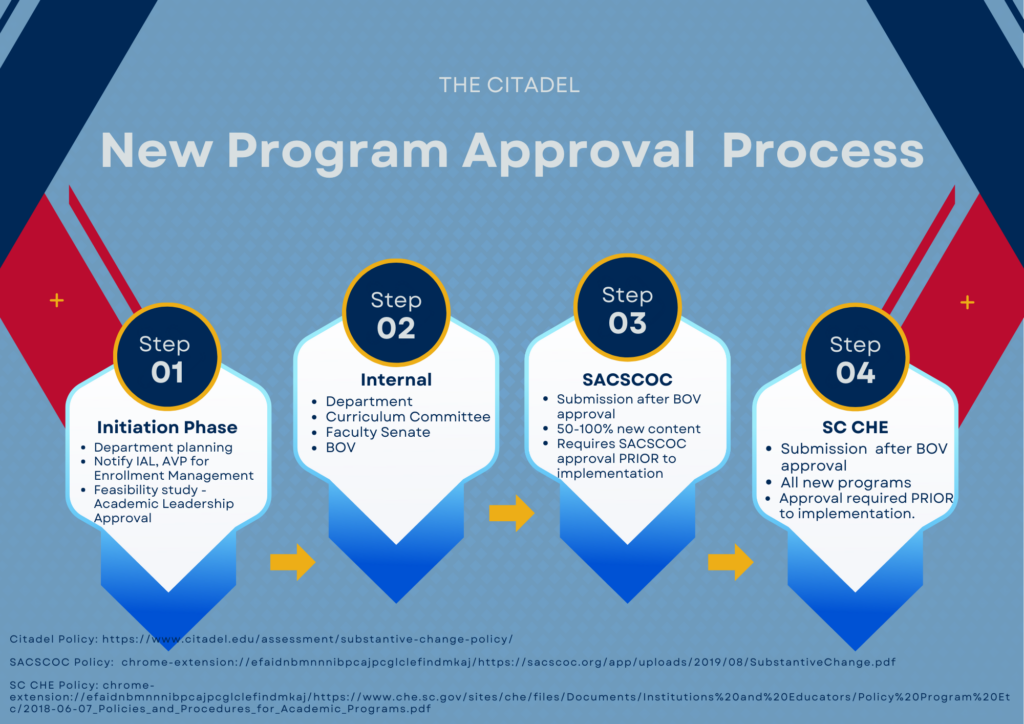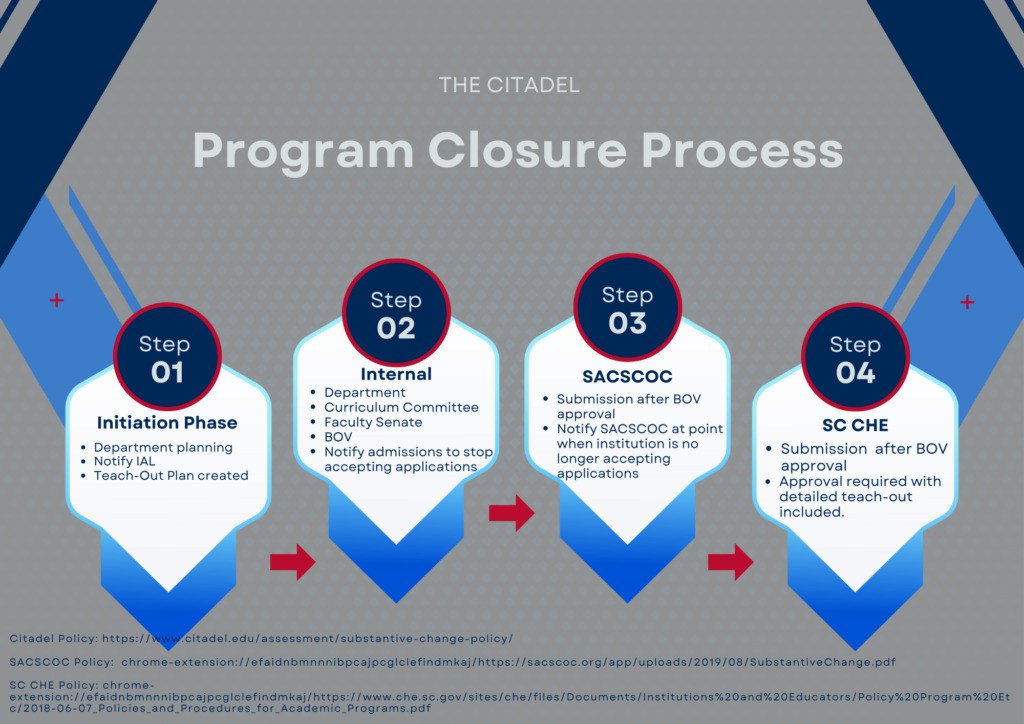As defined by SACSCOC, a substantive change is a significant modification or expansion of the nature and scope of an accredited institution. The reporting and review of substantive changes ensure that the scope of
programs offered by the institution, as well as the structure and organization of the institution, have undergone appropriate review by SACSCOC.
Source: SACSCOC Resource Manual for The Principles of Accreditation. Fourth Edition, 2024. P. 144
The Citadel’s Substantive Change Policy and Procedures
The Citadel’s Substantive Change Policy and Procedures
The Citadel, The Military College of South Carolina, is accredited by the Southern Association of Colleges and Schools Commission on Colleges (SACSCOC). The U.S. Department of Education recognizes SACSCOC as an agency whose accreditation enables its members to seek eligibility to participate in Title IV programs. As a standard of accreditation, The Citadel must notify the COC of substantive changes before they occur. Substantive change is a significant modification or expansion in the nature and scope of an accredited institution. The SACSCOC policy on substantive change incorporates federal requirements into its substantive change policy and procedures. The Citadel aligns itself with the SACSCOC policy and applies to all types of substantive changes.
see SACSCOC Substantive Change Policy
Policy Manager and Responsible Department or Office
The President is required to notify The Citadel’s accrediting organization of any proposed changes to the college’s essential structure. The Citadel’s faculty, staff and administration are obligated to assist in recognizing and reporting such substantive changes.
Contact Institutional Accreditation Liaison (IAL): Dr. Karin Roof, kroof1@citadel.edu
Purpose/Reason for the Policy
The purpose of this policy is to establish institutional procedures for recognizing and approving substantive change and ensuring timely notification to the Southern Association of Colleges and Universities Commission on Colleges (SACSCOC). “Substantive Change” – as it is termed by the SACSCOC – includes:
Substantially changing the established mission or objectives of an institution or its programs.
- Changing the legal status, form of control, or ownership of an institution.
- Changing the governance of an institution.
- Merging / consolidating two or more institutions or entities.
- Acquiring another institution or any program or location of another institution.
- Relocating an institution or an off-campus instructional site of an institution (including a branch campus).
- Offering courses or programs at a higher or lower degree level than currently authorized.
- Adding graduate programs at an institution previously offering only undergraduate programs (including degrees, diplomas, certificates, and other for-credit credential).
- Changing the way an institution measures student progress, whether in clock hours or credit-hours; semesters, trimesters, or quarters; or time-based or non–time-based methods or measures.
- Adding a program that is a significant departure from the existing programs, or method of delivery, from those offered when the institution was last evaluated.
- Initiating programs by distance education or correspondence courses.
- Adding an additional method of delivery to a currently offered program.
- Entering into a cooperative academic arrangement.
- Entering into a written arrangement under 34 C.F.R. § 668.5 under which an institution or organization not certified to participate in the title IV Higher Education Act (HEA) programs offers less than 25% (notification) or 25-50% (approval) of one or more of the accredited institution’s educational programs. An agreement offering more than 50% of one or more of an institution’s programs is prohibited by federal regulation.
- Substantially increase or decreasing the number of clock hours or credit hours awarded or competencies demonstrated, or an increase in the level of credential awarded, for successful completion of one or more programs.
- Adding competency-based education programs.
- Adding each competency-based education program by direct assessment.
- Adding programs with completion pathways that recognize and accommodate a student’s prior or existing knowledge or competency.
- Awarding dual or joint academic awards.
- Re-opening a previously closed program or off-campus instructional site.
- Adding a new off-campus instructional site/additional location including a branch campus.
- Adding a permanent location at a site at which an institution is conducting a teach-out program for students of another institution that has ceased operating before all students have completed their program of study.
- Closing an institution, a program, a method of delivery, an off-campus instructional site, or a program at an off-campus instructional site.
- Participating in the federal Prison Education Program providing Pell Grant access to confined or incarcerated students.
see SACSCOC Substantive Change Policy for how to address each type of substantive change.
Departments/Offices Affected by the Policy
The Citadel/All Units
Procedures Related to the Policy
Responsibilities of Administrators including Vice Presidents, Associate Vice Presidents, the Provost, Associate Provosts, Deans, Associate Deans, Department Chairs and Program Coordinators:
The administrative heads of both academic and non-academic units are responsible for being knowledgeable as to what SACSCOC considers a “significant modification or expansion of the nature and scope of an accredited institution” and for being aware of related accreditation information (see sacscoc.org).
Administrative heads of both academic and non-academic units are responsible for the development, implementation, and ongoing review of processes that are consistent with the substantive change policy, including publication of and adherence to relevant timelines, submission deadlines, and approval forms.
It is the duty of administrators to ensure that the college’s SACSCOC Accreditation Liaison is notified of planning for a modification that may prove substantive. The President remains informed of all substantive changes that require submission to SACSCOC. Implementation of a change that clearly is or may be substantive cannot occur until the College complies with SACSCOC procedures and receives approval as appropriate.
To ensure that proposals that may be considered substantive changes are reported correctly, it is recommended that all administrators review school/department annual reports, committee minutes, and other reports of institutional actions in light of the substantive change policy.
New Program Approval Diagram

Program Closure Diagram

